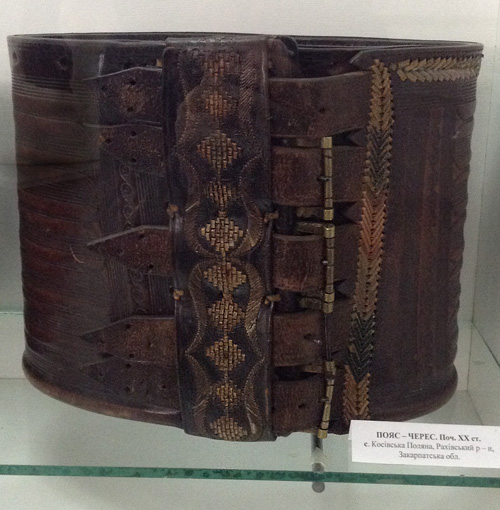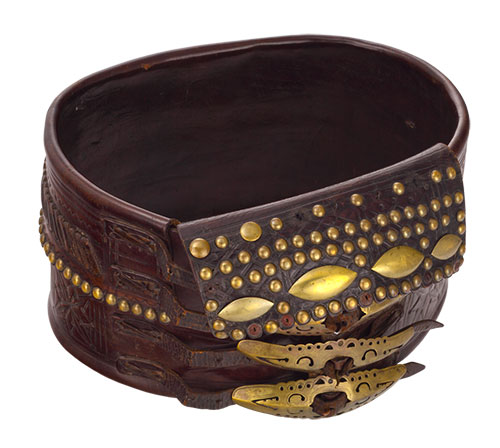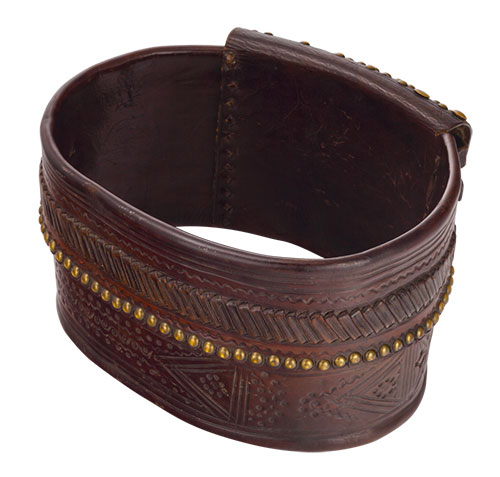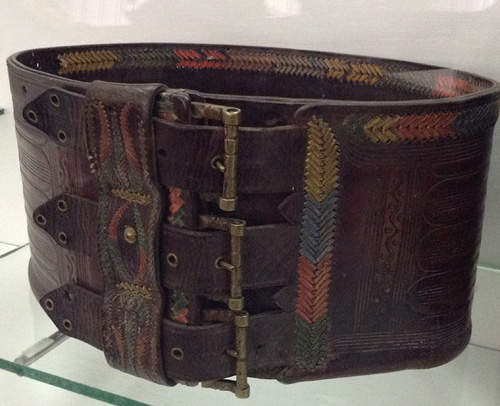 These beautiful and functional broad leather belts were used throughout the Carpathian area in several countries – Poland, Slovakia, Ukraine, Hungary, Romania, etc. They were a perfect accessory for men in the highlands. Such belts protected the body, served as back support, were used to carry money and small objects, and even were believed to have some mystical protective capabilities. And also, the design of wide leather belts was extremely artful and decorative – it’s one of the prettiest male accessories ever.
These beautiful and functional broad leather belts were used throughout the Carpathian area in several countries – Poland, Slovakia, Ukraine, Hungary, Romania, etc. They were a perfect accessory for men in the highlands. Such belts protected the body, served as back support, were used to carry money and small objects, and even were believed to have some mystical protective capabilities. And also, the design of wide leather belts was extremely artful and decorative – it’s one of the prettiest male accessories ever.
This broad leather belt has many names according to the country and region of origin: opasek, opaski, cheres, chimir, serpar, srose, etc.
But the appearance and function are always the same. It is made from thick raw leather, it wraps once around the waist and fastens with buckles or other similar fasteners, and it usually has a lot of decorative elements.
Function
Such curious belts were invented by Carpathian men to protect their bodies during hard labor and severe weather conditions. The main – but not the only – purpose was to protect the body during heavy-lifting.

Highlander’s belt called “cheres” from Ukraine. This one was made at the beginning of the 20th century in Rakhiv district, Transcarpathian region of Ukraine. It has five fasteners. It is stored in the National Museum of Hutsul and Pokuttya Folk Art in Kolomyia, Ukraine
Also, these belts:
- held clothes in place (though they didn’t hold trousers – other narrower strings and fabric belts were used instead, right under the opasek);
- they protected the belly from injury during the work in the woods;
- they provided added warmth in cool mountainous areas;
- they served as waterproof accessories for rainy weather;
- they were used to carry small objects and money (there were small pockets inside that couldn’t even be reached without taking the belt off). Usually, up to 3 pockets were made in one belt – to carry a pipe, tobacco, a knife, an awl, and other small tools and useful items.
How were they made?
Broad highlander’s leather belts were made from cowhide.
A belt could be dyed red or black or left undyed. Black belts were cheaper, as this color was used to hide different imperfections of leather. The most expensive and highly valued belts were dyed red, and they were made from the best leather.



Highlander’s belt called “opasek” from Poland, Podhale district, village of Ząb, the 19th century. It has 4 buckles and a front flap. This belt is very ornate and beautiful. It is stored in The Dr. Tytus Chałubiński Tatra Museum in Zakopane, Poland. Photos are from Małopolska's Virtual Museums
A piece of finished and dyed leather was folded a few times to form the shape of a belt. In some Carpathian areas, the shape was unusual – it had a special flap covering the belt face. It was more convenient as you didn’t scratch your hands with buckles and your sleeves didn’t catch buckles in the process of work.
Usually, there were 3-6 brass buckles, most often cute decorative buckles. The buckles were attached after the belt adornments were finished – adding buckles and leather straps was the last step.
Decorations
Opasek (opaski, cheres, chimir, serpar, srose) belts were practically always adorned with various decorative elements. They not only beautified the belt but also were believed to be protective symbols. As such belts were broad – sometimes up to 20-45 cm (8-18 inches) – there was plenty of place for embellishments. And so, these accessories were adorned with cutting, stamping, studding, embroidery, braiding, brass elements and buckles, and so on.
Usually, it took a lot of skill to create such a decorative belt, so there were professional craftsmen who made them. But sometimes, they were also produced by shoemakers and artisans who worked with leather.

Highlander’s belt called “cheres” from Ukraine. This one was made in the early 20th century in Verkhovyna district, Ivano-Frankivsk region. It has three buckles, some metal decorations, colorful embroidery, and stamping on leather. It is stored in the National Museum of Hutsul and Pokuttya Folk Art in Kolomyia, Ukraine
Some opasek belts were more ornate – the festive ones, others could be simpler – day-to-day belts of poor men. Everyday accessories had fewer decorations.
Except for the maker, the highlander’s belt could be decorated additionally by its owner. For example, some men attached decorative buttons, chains, medals, and other small adornments and memorabilia.
The highlander’s belts were popular in the Carpathian regions until the end of the 19th – the beginning of the 20th century. In this period, they gradually vanished from people’s daily use. Today, such belts are usually worn only for folklore festivals and similar occasions, together with local traditional attire.


